The project to give a facelift to the notorious 17.01 km Outer Ring Road (ORR) stretch between K.R. Puram and Central Silk Board has finally gained momentum. Bengaluru Smart Infrastructure Limited (BSMILE) has prepared and sent the draft detailed project report (DPR) to the government and is expected to come before the Cabinet on Thursday for approval.
The upgraded ORR will feature a 10-lane road, including a six-lane main carriageway (three lanes on each side) with a width of 10.5 m per side and four service lanes (two lanes on each side) with a width of 6 m per side. The road will also have footpaths ranging 2.5 m to 4 m wide on both sides, incorporating cycle lanes. A median ranging from 1 m to 4 m will separate the main carriageway and service lanes, depending on space availability and bus shelter placement, along with a 1-m-wide underground utility duct.
The project will revive the now-defunct 3.75-m-wide Bus Priority Lane (BPL) on both sides — a move aimed at reducing congestion and choke points. Doing away with the earlier model of bus shelter maintenance by private agencies, the Special Purpose Vehicle (SPV) will now construct and maintain state-of-the-art shelters on its own. Soft rumble strips, half a metre wide, will be placed between the main carriageway and the BPL.
The main carriageway will span 11 metres at elevated sections and narrow to 10.5 metres at the down ramps. The SPV has decided to reconstruct only 4 metres of the main carriageway under the Metro line (around the pillars), which deteriorated during Metro construction. The remaining 6 metres will receive a standard bituminous concrete overlay. The service lanes and footpaths will also undergo a complete makeover.
R.K. Mishra, Independent Director at BSMILE, told The Hindu that the white-topping plan was dropped considering the heavy traffic and ongoing metro work. However, three key locations—Marathahalli underpass, Kadubeesanahalli underpass, and Iblur Junction—will be white-topped to address critical infrastructure issues.
“We had initially planned a separate lane for cyclists, but due to space constraints, it will now be integrated into the footpath,” he said. The cycle track will resemble the one along Raj Bhavan Road in central Bengaluru.
The project’s cost, initially estimated at ₹400 crore, has now risen to ₹450 crore, according to the DPR prepared by Infra Support Engineering Consultants Pvt. Ltd. Mr. Mishra told The Hindu that the draft DPR is likely to be approved soon, after which tenders will be floated within ten days.
Sahil Bagla, Deputy Commissioner of Police (Traffic, East), said that bus shelters located on the main carriageway currently add to congestion on the stretch. Supporting his point, Gopal M. Byakod, DCP (Traffic, South), noted that several skywalks have been built unscientifically, forcing pedestrians to cross service lanes since the exits open toward the median.
With the introduction of the bus priority lane, the issue of bus shelters encroaching on the main carriageway will be completely resolved. Only buses will use the dedicated lane, eliminating traffic buildup behind them. There will also be no provision for buses to overtake.
“We are also studying whether metro station stairways can be opened for public use, even for those not taking the metro. This could help address the current skywalk issues,” Mr. Mishra told The Hindu.
The project is being touted as a potential solution to ORR’s congestion problems. However, the challenge lies in the road’s extremely high traffic volume. Originally designed to handle 4,800 Passenger Car Units (PCUs), the road currently accommodates about 10,400 PCUs, according to data on ASTraM. The project aims to correct design flaws and promote public transport usage through the bus priority lanes.
Meanwhile, Metro Phase 2A—Blue Line—will be completed by the end of next year, according to Yeshwanth Chavan, Chief PRO of BMRCL. Once the metro line becomes operational, he expects around 1.5 lakh commuters to use it. However, the ORR currently carries between 8 and 10 lakh commuters every day.

 1 week ago
11
1 week ago
11








 English (US) ·
English (US) ·